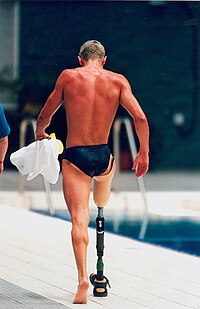
Photo from wikipedia
Bone grafting is necessary before dental implant treatment in patients with jaw bone defects. Currently, autologous bone grafting is a major burden on the patient. However, it is impossible to… Click to show full abstract
Bone grafting is necessary before dental implant treatment in patients with jaw bone defects. Currently, autologous bone grafting is a major burden on the patient. However, it is impossible to form a sufficient foundation for the implant with a bone-filling agent alone. It is, therefore, necessary to prepare hybrid artificial bone tissue containing osteoblasts and osteoclasts. In this study, mouse MC3T3-E1 pre-osteoblast cells and human embryonic-derived osteoblastic cell line hFOB1.19 were cultured in radial-flow bioreactors (RFB) to form three-dimensional artificial bone filled with porous beads of β-tricalcium phosphate (β-TCP) or hydroxyapatite (HA)—which are clinically used as bone-filling agents—as cell culture carriers. When circulation culturing was performed in the growth medium for the first 10–12 days, glucose consumption was increased in the cultures with HA beads in comparison to the cultures with β-TCP beads. When cultured in the differentiation culture medium during the second half of the culture period, the glucose consumption decreased in the culture with HA beads. A DNA microarray analysis suggested that osteogenesis progressed fast in three-dimensional culture filled with HA beads and that partly differentiation into osteoblasts was prominent in cultures with β-TCP beads. In the growth process of MC3T3-E1 cells, the vitamin A metabolism was also activated, the synthesis and degradation of retinoic acid was enhanced, and the metabolism of the same process decreased at the end of differentiation in three-dimensional cultures. Three-dimensional circulation culture in RFB is considered to be useful for the formation of hybrid bio-artificial bone tissue.
Journal Title: Human Cell
Year Published: 2018
Link to full text (if available)
Share on Social Media: Sign Up to like & get
recommendations!